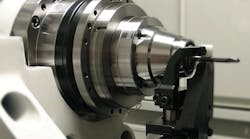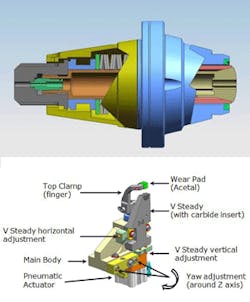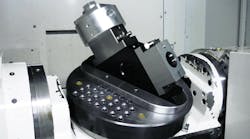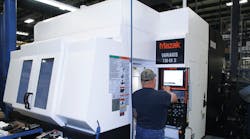MicroPlus, a new workholding and tool support system, significantly reduces tool run-out during grinding, according to the Australian firm that developed it, thus making it possible to produce tools with higher precision — and without extending cycle times.
Melbourne-based ANCA is designs and produces CNC tools and cutter grinders, and boasts it supplies tool grinders for every application from large-scale manufacturing to entry-level production requirements. ANCA also develops tool design software and machines to producing a variety of complex tools, including grinding end mills, profile cutters, burrs and punches.
The two-component MicroPlus system limits radial and axial run-out consistently to less than 3 microns (0.0001 in.) for tools that measure 50 mm (2 in.) from the face of the collet. Typical tool grinder run-out is about 0.0002 in., the developer noted. The new system is suitable for manual or automated tool loading; it is particularly applicable for production grinding of 3- to 13-mm diameter tools.
ANCA added that it is “a conveniently packaged system (in which) collets are easily changed over and the machine work envelope is unrestricted.”
ANCA’s MicroPlus system consists of two separate assemblies: the Flexi-Chuck assembly for workholding and the Overhead Top Clamp assembly (OTC) for tool guidance. Together, it said, these devices provide a system that delivers consistently lower run-out than any existing system.
Clamping and rotating
The Flexi-Chuck clamps and rotates the tool to be ground, preventing any negative influences from affecting the guidance provided by the OTC, such as collet inaccuracy, inconsistent collet clamping, or any misalignment caused by loading tools.
Disc spring stacks within the Flexi-Chuck assembly generate the clamping force. This provides sufficient force to clamp tools effectively. Flexi-Chuck does not use the conventional draw bar design, and as such it is not affected by a drawbar system’s potential negative influence on tool run-out.
In other systems, if the drawbar and tool are misaligned and not in a completely straight line, the drawbar tends to pull the tool at an off-center angle, causing run-out. Also, rigid draw bar-mounted collets can over-limit the workholding system, commonly preventing the V-steady from controlling tool guidance.
The Flexi-Chuck allows the tool and the internal components that lead to it to move independently of each other, absorbing any potential misalignment. With MicroPlus, tool guidance is achieved by the Overhead Top Clamp assembly and the collet float of the Flexi-Chuck. This allows the Overhead Top Clamp to guide the tool into an accurate workholding position without the Flexi-Chuck influencing the accuracy of the tool alignment.
This new workholding part of the MicroPlus uses the flat-nose Schaublin W20 range of collets. Collet sizes range from 1-13 mm (1/32-0.5 in.)
To provide the tool with accuracy for run-out and alignment, the Overhead Top Clamp consists of a rigid V block that supports the tool to ensure axial and angular alignment. The OTC retains the tool in the precision V block with an overhead clamp.
The clamp is a rigid metal finger with an acetal pad to prevent damage to the tool shank during grinding. The OTC is mounted on a rigid steady bed, and the tool is clamped and unclamped by a pneumatic actuator. The operator can adjust pneumatic clamping pressure of the finger to suit different tool types and diameters.
ANCA's ToolRoom software supplies automated assistance to set-up the MicroPlus workholding device. This will help machine tool operators to set the centerlines of the Overhead Top Clamp assembly with the Flexi-Chuck, in both vertical and horizontal planes.
Currently, MicroPlus is available as an option for the MX7, GX7 and RX7 tool grinders, and it can be retrofitted to those machines.









